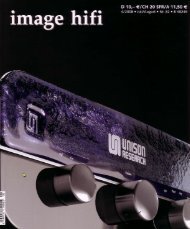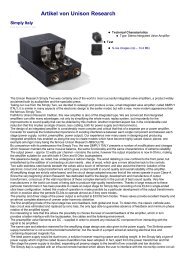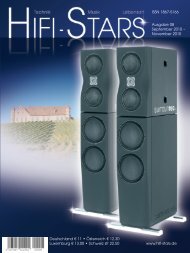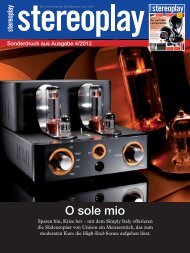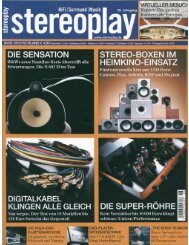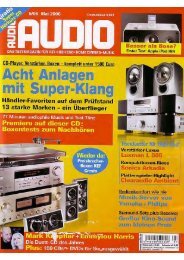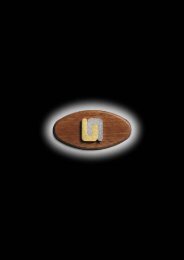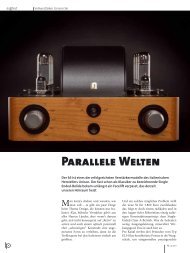Malibran - Unison Research
Malibran - Unison Research
Malibran - Unison Research
You also want an ePaper? Increase the reach of your titles
YUMPU automatically turns print PDFs into web optimized ePapers that Google loves.
<strong>Malibran</strong>
Maria <strong>Malibran</strong> or Maria Felicia García was born in Paris on march the 24th, 1808 and died in<br />
Manchester on September the 23th, 1836. Her father was the great tenor Manuel Garcia, her sister<br />
Pauline Viardot-Garcia was a singer too. Maria <strong>Malibran</strong>‘s voice was exceptional for range, power<br />
and flexibility and she could sing as contralto and soprano. She was a great interpreter, actress<br />
and also a composer. Maria <strong>Malibran</strong> fell off her horse and died. She was only 28 years old and<br />
immediately become a leggend.<br />
The goal of the <strong>Malibran</strong> is to reproduce quality of our top models in smaller cabinet while<br />
increasing the bass dinamic and making easier the room placement.<br />
The <strong>Malibran</strong> model is the first loudspeaker system designed by Opera and produced by <strong>Unison</strong><br />
research. The <strong>Malibran</strong> model implement all the technical solutions developed by Opera including<br />
the bass section developed for the Grand Callas model: the “progressive” low pass filter, the CLD<br />
(Crossed Linked Dipole) and the TEB (sealed enclosure) for the three woofers.<br />
<strong>Malibran</strong> model is a 146 litres, over 120 Kg., floor standing loudspeaker. We have reduced the size<br />
while increasing the low frequency response. The <strong>Malibran</strong> as a two-way system with a powerful<br />
passive sub-woofer and the CLD in the same cabinet. On the <strong>Malibran</strong>' s front panel there are four<br />
mid-woofer and the tweeter which are responsible for the direct sound (and a lot of the reflected<br />
sound as well). The front system consist of four “state of the art” mid-woofers and tweeter. Three<br />
10" woofers are placed on one side of the cabinet. On the rear side of the <strong>Malibran</strong> cabinet there is<br />
the CLS rear radiating system with 4 tweeters high-pass filtered at 2 kHz. For more information<br />
about CLD and progressive filter see the attached documentation. Many efforts have been spent to<br />
make the <strong>Malibran</strong> easy to be placed in the room.
Cabinet<br />
The cabinet of the <strong>Malibran</strong> model is made in finely-shaped multiplayer and thick MDF veneered in<br />
real wood finely polished. Front pannel is lined in leather that act as a washer for loudspeaker. The<br />
MDF front panel is 4 centimeter thick and milled on both side to avoid cavitation of the air flow. The<br />
curved multilayer sides are 3 cm thick while the rear MDF panel is six cm thick. The cabinet is<br />
really heavy and rigid.<br />
The internal volume of the cabinet is divided so that each woofer has its own volume separated<br />
from midrange volume. Also the midrange chamber is divided into two separated volumes to avoid<br />
standing waves. All this reinforces the structure and raises the frequency of the normal standing<br />
waves so that they are easily pulled down by the absorbing material. The inside of the cabinet is<br />
filled with a good quantity of acrylic wadding which eliminate internal reflections and aids bass<br />
frequency damping.<br />
Drivers<br />
The 10" woofer is a new device developed by Seas that exhibit a very long linear excursion (28<br />
mm pk-pk), an aluminium diaphragm and all the technical solution one need to reduce distortion<br />
like copper rings and rear holes for de-compression. Though you may use a single woofer in a<br />
reflex cabinet we choose to use three woofers in three separated sealed enclosures. In this way a<br />
couple of <strong>Malibran</strong> is able to move 3 litres of air. During normal use the displacement of each driver<br />
is so small that distortion and compression are reduced to negligible values. The woofer has a very<br />
stiff aluminium cone, natural rubber surround and aluminium voice coil former. This woofer has<br />
an excellent response up to 1000 Hz with very low distortion as requested for this design.<br />
The <strong>Malibran</strong> model uses four mid-woofer drivers with the progressive low-pass cross-over. The<br />
Mid-wooder is a 5" cone driver developed for use as a high fidelity Woofer/Midrange unit. The<br />
extremely stiff, yet light cone and the acoustically transparent basket give tremendous bass<br />
precision and midrange detail. Precision cast and surface treated magnesium cone coupled to a<br />
natural rubber surround showing no sign of midrange (edge) resonances. Heavy copper rings<br />
mounted above and below the T-shaped pole piece, to reduce non linear and modulation distortion<br />
and to increase overload margin. Gold plated terminals mounted on a stiff glass fibre reinforced<br />
plate to reduce contact resistance and improve reliability. Extremely stiff and stable injection<br />
moulded metal basket to keep the critical components in perfect alignment. Large windows in the<br />
basket both above and below the spider to reduce sound reflection, air flow noise and cavity<br />
resonance to a minimum. That means, also thanks to the wide linear excursion of the moving coil,<br />
little distortion and negligible compression.<br />
Thanks to the high radiating surface and to the top quality of the drivers the <strong>Malibran</strong> model exhibit<br />
a very low harmonic and intermodulation distortion. The tweeter is the well known and valued<br />
Scanspeak 9700 model. You find one tweeter on the front panel, for direct sound, and four of them<br />
on the rear side to form the CLD unit that feeds the reverberant field in the room. The 9700 tweeter<br />
has a very low distortion (substantially of the second order) and can support a great amount of<br />
power thanks to the wide linear displacement allowed. The very low resonance frequency allowa a<br />
simple filtering with a 2KHz/12dB high pass filter with a minimum number of components.
Compression and Distortion<br />
As current flows through the loudspeaker’s moving coil the temperature increases and alter the<br />
ohmic resistance as well as other driver’s parameters. With multiple drivers the power coming from<br />
the amplifier is reduced 3 times (woofer section) or 4 times (midrange section) and the temperature<br />
of each driver remains low: this avoid compression effects and transient distortion.<br />
In the <strong>Malibran</strong> model harmonic distortion is lower than 0.32 % from 50 to 20000 Hz for 90 dB SPL<br />
output (at one meter) with minimum values less then 0.1% in the mid-bass region around 200 Hz.<br />
These are values that you can define good for a valve amplifier. That means great details, no<br />
listening fatigue, and great sound transparency. In most situations distortion components will be<br />
lower than the acoustic noise level in your listening room.<br />
Low Frequency Section<br />
Each 10” sub-woofer has its own 40 litres chamber and they all work in TEB (Totally Enclosed<br />
Box). The maximum dimension of each chamber is about 80 cm and the frequency of then first<br />
standing wave is higher than the cross over frequency. Efficiency of the TEB is not as high as a<br />
reflex alignment can be, but TEB gives some advantages: there are no duct (no cavitation noise)<br />
and no passive radiators (no mechanical losses) and the cone movements is fully controlled by its<br />
rear air volume. The low frequency slope of the TEB is less sharp than reflex one and so the bass<br />
are more deep. Last but not least a TEB system is easier to place in the room.<br />
<strong>Malibran</strong>' s woofer are placed in an uncommon position: they are all on the same side of the<br />
cabinet. In this way the great part of the acoustic load at low frequency is due to the large cabinet<br />
itself, only a little part of the acoustic load, at the very low frequency, still depends upon lateral<br />
walls. This make the <strong>Malibran</strong> insensible to the relative position of the lateral walls. The woofers of<br />
the right channel should face those of the left channel.<br />
The acoustic barycentre of the woofers is placed at middle height of the cabinet and about 25 cm<br />
behind the mid-woofers (not below the midrange as usual in a three way system) . They radiate the<br />
upper part of their frequency range toward the rear wall. The sound radiation become directional<br />
stating from 100 Hz: most acoustic energy is concentrated in the region between the rear wall and<br />
the listening point. Less energy than usual reflect on floor and ceiling. Also this effect contribute to<br />
make the <strong>Malibran</strong> model less sensitive respect the position in the room.<br />
Woofer’s vertical dispersione plot at 100, 150 and 200 Hz
The Cross-over<br />
The <strong>Malibran</strong> cross-over is not as complicated as it may seem (consider there are 12<br />
loudspeakers!). There are four section:<br />
rear tweeters (CLD)<br />
front tweeter<br />
midrange<br />
woofer<br />
Two switches allow to alter the mid-bass response ant the front tweeter level. The CLD emission<br />
level is fixed.<br />
Cross-over frequencies are 160 or 200 (woofer-midrange) and 2000 Hz (midrange-tweeter) with<br />
12 dB per octave slope. The cross-over is divided into several different boards to keep coils far<br />
from each other avoiding cross-talk due to magnetic induction. The woofers are connected out of<br />
phase, mid and tweeter are in phase.<br />
In the following figure you can see the emissions of many instrument and voices and how they are<br />
reproduced by the <strong>Malibran</strong> model: for example the contralto and soprano voices (but also the<br />
violin, oboe, flute, octavin, viola) are fully reproduced by <strong>Malibran</strong>’ s midranges. In our opinion<br />
choosing a low cross-over frequency between woofer and midrange gives a better performance<br />
and a more natural vertical dimension to the sound stage.
The “isotipica” region, mono recordings<br />
In the Italian literature you find the definition of the “isotipica” region (literal: same kind region).<br />
When you are inside the isotipica region you hear the mono signals as coming from the centre of<br />
the two stereo channels. The “isotipica region” is usually small. This is a problem when there are<br />
many people listening. One way to enlarge the isotipica region is to increase the number of<br />
sources ( two for the right and two for the left channels). As the isotipica region enlarge, the<br />
focusing of the mono recordings became poorer. The rear system acts as a second couple of<br />
sources that is about 60 cm. behind the “main” source and thus “enlarge” the isotipica region but<br />
this happen only at high frequency and is distinguishable only with mono recordings.
Technical Specifications: Opera <strong>Malibran</strong><br />
System<br />
Loudspeakers<br />
Number of Way<br />
Frequency response<br />
Cross-over<br />
Maximum power (long<br />
period)<br />
Maximum power (music)<br />
Suggested amplifier<br />
Sensibility<br />
Nominal impedance<br />
Position within<br />
surroundings<br />
Floor Standing - TEB<br />
Finishing: cherry and leather<br />
Three 10” sub-woofers, aluminium cone<br />
Four 5” midrange, magnesium cone<br />
One 1” inch front tweeter – silk dome, decompression chamber<br />
CLD rear radiating system (four tweeter)<br />
3 ways + rear CLD<br />
20 -20000 Hz<br />
Hard wiring<br />
12 dB/octave for the woofer<br />
12 dB with progressive low pass for midrange<br />
12 dB/octave High pass for the tweeter<br />
Cross-over frequency 160-200 and 2000 Hz<br />
750 watt RMS (IEC signal)<br />
Crest factor > 14 : no practical limit<br />
Crest factor > 4 : 1500 watt. (no clipping)<br />
From 10-15 Watt RMS (without clipping)<br />
89 dB/2.83 Volt/1 metre<br />
4 ohm (Zmin >3.2 ohm)<br />
At least 30 cm from rear wall (avoid angle position)<br />
Dimensions 140 x 39 x 80 cm ( H x L x D ) 55 x 15.3 x 31.4<br />
Net Weight 125 Kg 275 pound x speakers<br />
Packed weight 150 Kg 330 pound x speakers






